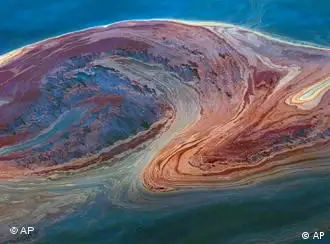Service
Oil leak solutions keep pouring in from readers
The oil leak continues to plague the Gulf of Mexico and our readers are sending in a wide variety of ideas for fixing the problem.

The spill is prompting desperate measures to contain the environmental fallout
The following comments reflect the views of DW-WORLD.DE readers. Not all reader comments have been published. DW-WORLD.DE reserves the right to edit for length and appropriateness of content.
Oil spill efforts fail; BP calls on general public for suggestions
Lower a large steel or concrete cylinder over the area with a cutout for the broken pipe in the side and open at the top. Then lower a series of inverted flower pot structures over this base until a final piping cap can bring the pluming oil and gas to the surface. -- William, US
Perhaps an explosive charge could be sent down to the pipe in the form of a tank shell. A bubble stream is at the front pushing the liquid oil to the side as it descends, exploding five to six hundred meters below the ocean floor stopping the oil from reaching the surface area. -- Malcolm, Canada
Using a pole, insert a simple inflatable balloon device (will need to be heavy duty material and several feet long) with ridges on it, inside of the ruptured pipe so that when inflated it will stop the flow of oil. Then put a permanent cap on the broken oil pipe. -- Craig, US
Capping does not seem to work. I suggest inserting pipe into the casing and injecting liquid nitrogen (minus 326 degrees Fahrenheit), freezing the oil solid. This would form a plug. Use an insulated tube for delivery from the surface vessel and keep the oil solid until capping is worked out. NASA knows about cryogenic transfer, maybe they can help. -- Anonymous, US
Why not lower a very large tapering steel weight shaped like a metal punch into the pipe and if needed drive it home to at least slow the leak until a more suitable process can be incorporated. It could be lowered by a cable and then guided below with a submersible. The weight and size of the object should be determined by the size of the hole and the pressure of the oil. -- Alan, US
Use dynamite or some kind of explosive to set the oil on fire so it will not flow as muck and may just disintegrate as it is burned. -- Barbara, US
Send down a weighted hoop attached to which is a long sleeve. The sleeve could be made from inexpensive materials, even PVC tarpaulins, one hooked to the next through the grommets. The uppermost part of the sleeve could be funnel-shaped to increase its diameter and held in place by floats attached to the larger hoop on the surface. The goal is to capture the oil, not plug the leak, not initially anyway. At the surface, the oil slick can then be vacuumed up into vessels equipped with filtering devices of even the most basic type. As oil and water do not mix, the extraction should be relatively simple. The filtering is then the problem. But the remaining water from the process could even be shipped to land for more extensive filtering if necessary, or treated with the microbial dispersants at its less oil-laden state. -- John, US
Use a 50 ton, loose sand bag. Lower that with a crane, over the pipe. -- Robert, US
Lower 10 foot high steel box with no top around broken vent. Then lower a much larger 15 foot high box around first box. Then fill the area between the two boxes (up to height of 10 feet) with cement that hardens under water. Once the cement is cured, fill the small box with material which could be medium-sized rocks or large ball bearings to block most of flow. Then fill the remaining space in the boxes with cement. When all is cured more weights or cement could be added over the area for a permanent seal. -- Henry, Canada
I suggest a thermonuclear explosive device placed directly atop the leak. The explosion will collapse the leaking pipe and the surrounding sea floor and fuse the seal floor into glass stopping the leak. The extreme depth will contain and prevent much of the radioactive debris from spreading. -- Al, US
If an external circular pipe cutter with a 14 inch blade could be lowered and placed on top of the pipe about 36 inches from the opening, it could cut the pipe without moving it, up to the pipe's inside bottom. Without cutting the lower section, if it's left in place using the same water pressure to keep it there, that same blade will act as a major stopper making it easier to seal it, covering with cement or other means. -- Carlos, US
Compiled by Stuart Tiffen
Editor: Rob Turner
DW recommends
- Date 26.05.2010
- Print Print this page
- Permalink https://p.dw.com/p/NXR2
- Date 26.05.2010
- Print Print this page
- Permalink https://p.dw.com/p/NXR2


